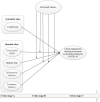Does Citizen Engagement With Government Social Media Accounts Differ During the Different Stages of Public Health Crises? An Empirical Examination of the COVID-19 Pandemic
- PMID: 35774579
- PMCID: PMC9237959
- DOI: 10.3389/fpubh.2022.807459
Does Citizen Engagement With Government Social Media Accounts Differ During the Different Stages of Public Health Crises? An Empirical Examination of the COVID-19 Pandemic
Abstract
Background: The COVID-19 pandemic has created one of the greatest challenges to humankind, developing long-lasting socio-economic impacts on our health and wellbeing, employment, and global economy. Citizen engagement with government social media accounts has proven crucial for the effective communication and management of public health crisis. Although much research has explored the societal impact of the pandemic, extant literature has failed to create a systematic and dynamic model that examines the formation mechanism of citizen engagement with government social media accounts at the different stages of the COVID-19 pandemic. This study fills this gap by employing the Heuristic-Systematic Model and investigating the effects of the heuristic clues including social media capital, information richness, language features, dialogic loop, and the systematic clue including content types, on citizen engagement with government social media across three different stages of the pandemic, employing the moderating role of emotional valence.
Methods: The proposed model is validated by scraping 16,710 posts from 22 provincial and municipal government micro-blog accounts in the Hubei province, China.
Results: Results show that the positive effects of social media capital on citizen engagement were observed at all stages. However, the effects of information richness, language features, dialogic loop, and content types, and the moderating effect of emotional valence, varied across the different pandemic development stages.
Conclusions: The findings provide suggestions for the further effective use of government social media, and better cope with crises. Government agencies should pay attention to the content and form of information shared, using technical means to analyze the information needs of citizens at different stages of public health emergencies, understanding the content most concerned by citizens, and formulating the content type of posts.
Keywords: citizen engagement; crisis stage; dialogic communication; government social media; information richness; language features; public health crisis; social media capital.
Copyright © 2022 Zhang, Yuan, Zhu, Chen and Evans.
Conflict of interest statement
The authors declare that the research was conducted in the absence of any commercial or financial relationships that could be construed as a potential conflict of interest.
Figures








Similar articles
-
Promote citizen engagement with warnings - an empirical examination of government social media accounts during public health crises.BMC Public Health. 2025 Apr 23;25(1):1508. doi: 10.1186/s12889-025-22760-x. BMC Public Health. 2025. PMID: 40269916 Free PMC article.
-
Factors Driving Citizen Engagement With Government TikTok Accounts During the COVID-19 Pandemic: Model Development and Analysis.J Med Internet Res. 2021 Feb 4;23(2):e21463. doi: 10.2196/21463. J Med Internet Res. 2021. PMID: 33481756 Free PMC article.
-
Promoting Public Engagement during the COVID-19 Crisis: How Effective Is the Wuhan Local Government's Information Release?Int J Environ Res Public Health. 2020 Dec 26;18(1):118. doi: 10.3390/ijerph18010118. Int J Environ Res Public Health. 2020. PMID: 33375307 Free PMC article.
-
Equity-informed social media COVID-19 risk communication strategies: a scoping review.BMJ Open. 2024 Aug 12;14(8):e085630. doi: 10.1136/bmjopen-2024-085630. BMJ Open. 2024. PMID: 39134442 Free PMC article.
-
The role of social media in public health crises caused by infectious disease: a scoping review.BMJ Glob Health. 2023 Dec 28;8(12):e013515. doi: 10.1136/bmjgh-2023-013515. BMJ Glob Health. 2023. PMID: 38154810 Free PMC article.
Cited by
-
Sexually transmitted diseases and immunology articles pushed by WeChat official accounts are of most interest to the Chinese public: A national cross-sectional study in China.Heliyon. 2025 Jan 9;11(2):e41820. doi: 10.1016/j.heliyon.2025.e41820. eCollection 2025 Jan 30. Heliyon. 2025. PMID: 39877601 Free PMC article.
-
Promote citizen engagement with warnings - an empirical examination of government social media accounts during public health crises.BMC Public Health. 2025 Apr 23;25(1):1508. doi: 10.1186/s12889-025-22760-x. BMC Public Health. 2025. PMID: 40269916 Free PMC article.
-
Dialogic communication on local government social media during the first wave of COVID-19: Evidence from the health commissions of prefecture-level cities in China.Comput Human Behav. 2023 Jun;143:107715. doi: 10.1016/j.chb.2023.107715. Epub 2023 Feb 17. Comput Human Behav. 2023. PMID: 36846271 Free PMC article.
-
Striving for wellbeing digitally in the city amidst the pandemic: Solidarity through Twitter in Ankara.Habitat Int. 2023 Jul;137:102846. doi: 10.1016/j.habitatint.2023.102846. Epub 2023 May 25. Habitat Int. 2023. PMID: 37251700 Free PMC article.
-
Cyber anti-intellectualism and science communication during the COVID-19 pandemic: a cross-sectional study.Front Public Health. 2025 Jan 15;12:1491096. doi: 10.3389/fpubh.2024.1491096. eCollection 2024. Front Public Health. 2025. PMID: 39882127 Free PMC article.
References
-
- Chatfield AT, Reddick CG. All hands on deck to tweet #sandy: networked governance of citizen coproduction in turbulent times. Gov Inf Q. (2018) 35:259–72. 10.1016/j.giq.2017.09.004 - DOI
-
- Radwan AF, Mousa SA. Government communication strategies during coronavirus pandemic: United Arab Emirates lessons. J Health Manag. (2020) 22:516–27. 10.1177/0972063420983091 - DOI
-
- Zhang W, Xu X, Zhang H, Chen Q. online participation chaos: a case study of Chinese government-initiated E-polity square. Int. J. Public Admin. (2016) 39:1195–202. 10.1080/01900692.2015.1072218 - DOI
Publication types
MeSH terms
LinkOut - more resources
Full Text Sources
Medical
Miscellaneous

